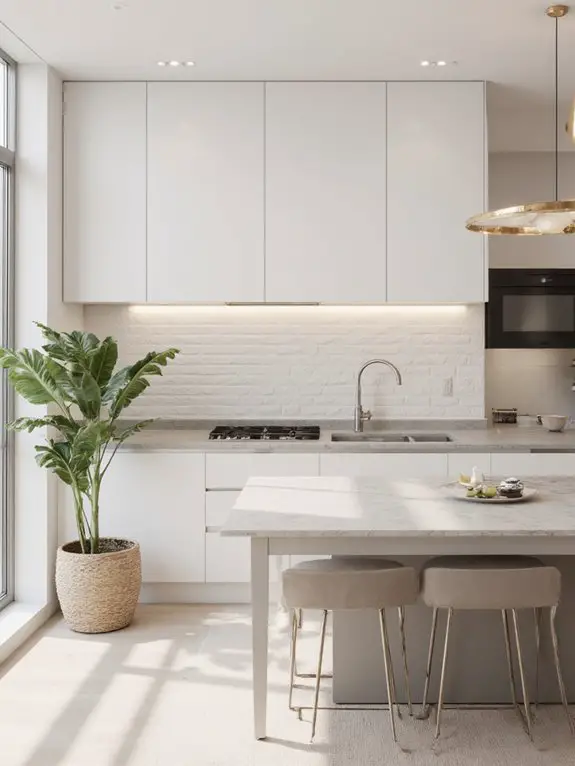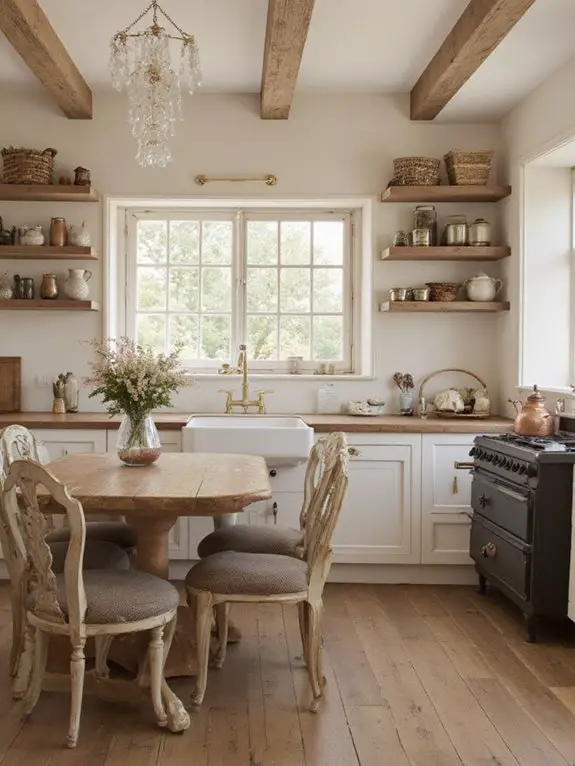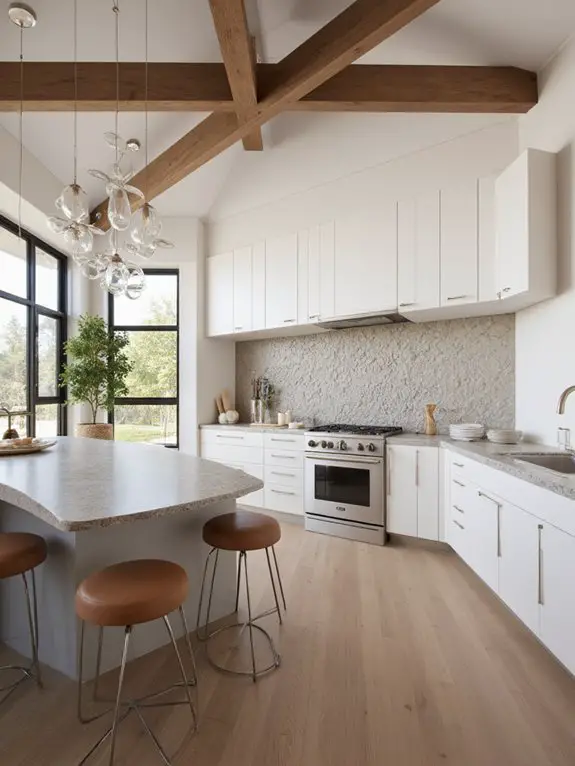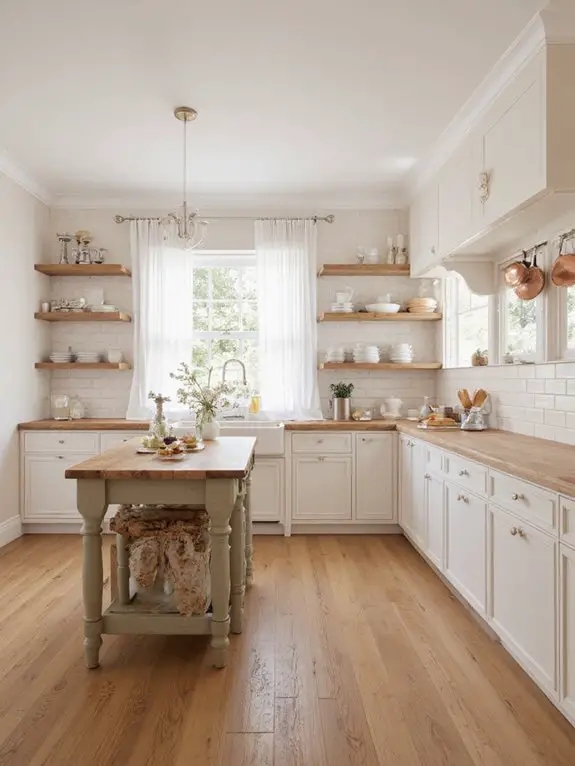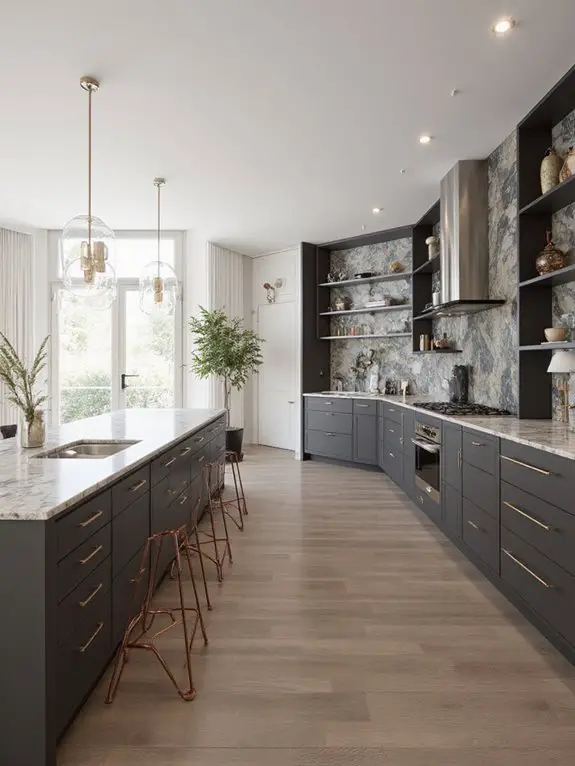Choosing the right cabinet color can transform your kitchen, setting the tone for style and functionality. Classic white offers a clean, timeless look, while soft gray brings modern neutrality. Navy blue adds drama, and forest green creates a cozy yet striking atmosphere. For warmth, consider taupe or burgundy, and for a touch of elegance, espresso or pastel lavender works beautifully. Each shade can enhance your kitchen’s aesthetic—discover how these colors can inspire your next design update.
Classic White
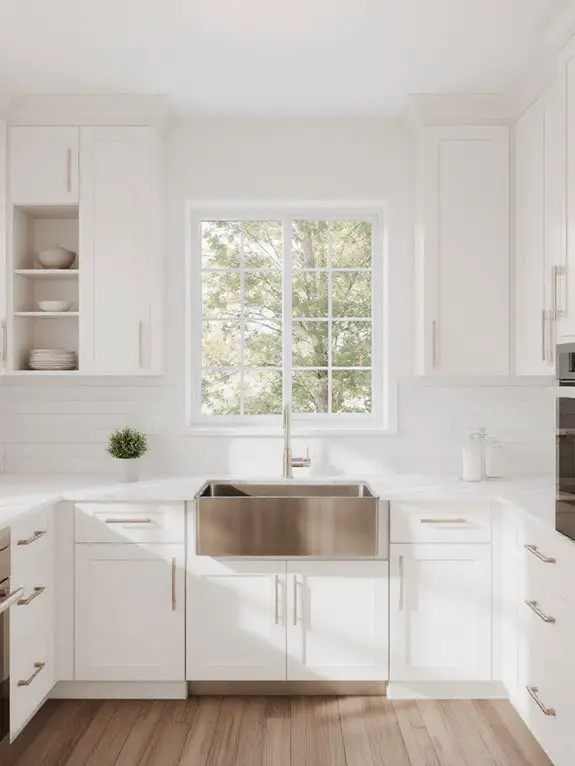
While white might seem like a safe bet, it’s anything but boring when it comes to kitchen cabinets. I’ve found that white cabinets create a timeless, clean backdrop that allows other design elements to shine.
They’re incredibly versatile, pairing perfectly with bold countertops, vibrant backsplashes, or metallic hardware. I always recommend choosing a shade with warm or cool undertones to complement your space—crisp whites work well in modern kitchens, while creamy whites add warmth to traditional designs.
Plus, they make small kitchens feel larger and brighter. White cabinets are easy to maintain, and a quick wipe keeps them looking fresh for years.
Timeless Black
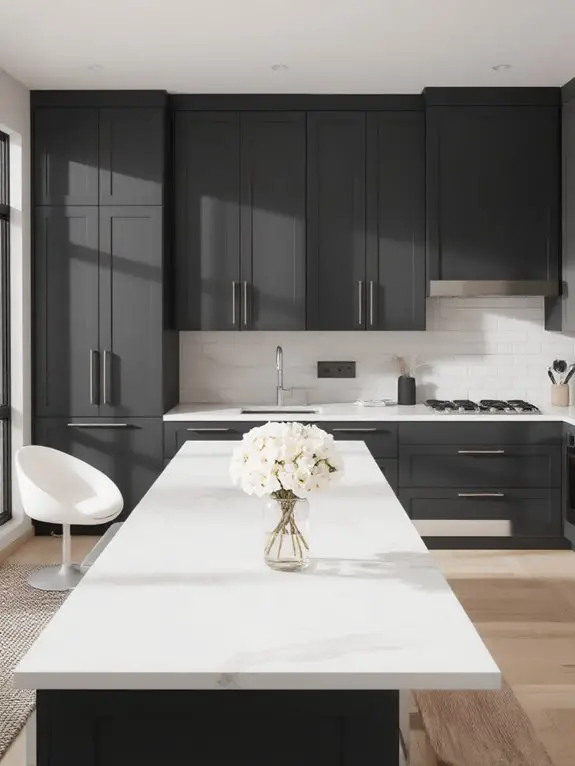
When I think of timeless sophistication in kitchen design, black cabinets stand out as a bold yet enduring choice. They bring depth and drama to any space, creating a striking focal point that pairs beautifully with various materials like marble, brass, or wood.
I’ve found that black works exceptionally well in both modern and traditional kitchens, offering versatility that adapts to evolving trends. To avoid a heavy feel, I recommend balancing it with ample lighting, reflective surfaces, or lighter countertops.
Black cabinets also hide smudges and wear better than lighter shades, making them practical for busy households. They’re a confident, elegant investment.
Soft Gray
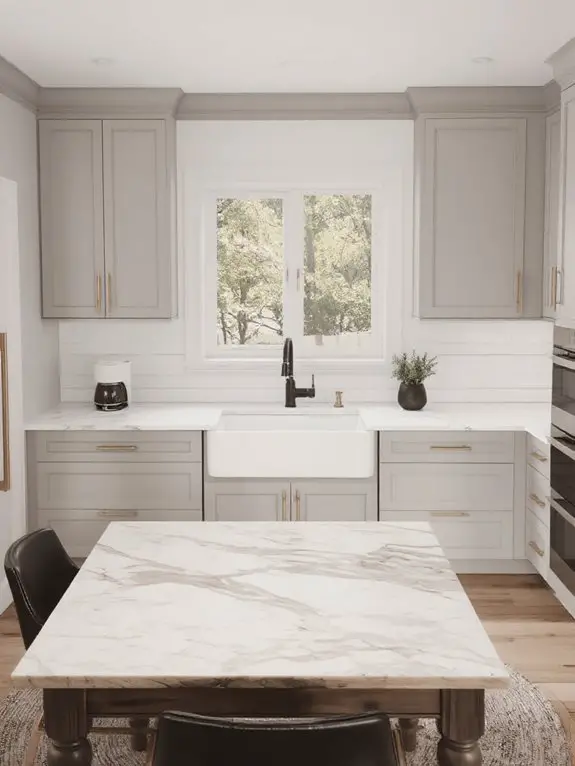
Soft gray cabinets offer a calming and versatile alternative to bolder colors, blending seamlessly into a range of kitchen styles. I’ve found that their neutral tone creates a serene backdrop, allowing other elements like backsplashes or countertops to shine. Whether I’m aiming for a modern, farmhouse, or minimalist look, soft gray adapts effortlessly.
Pairing it with warm brass hardware adds subtle sophistication, while matte finishes enhance the understated elegance. I also appreciate how it reflects natural light, making smaller kitchens feel more spacious.
For a cohesive design, I often combine soft gray with white accents or natural wood tones for a balanced, timeless aesthetic.
Navy Blue
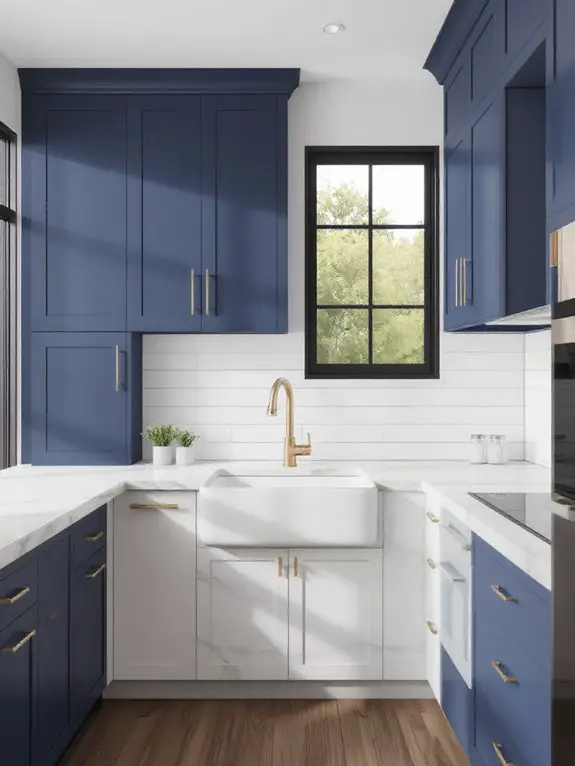
Moving from the understated elegance of soft gray, navy blue cabinets bring a bold and sophisticated statement to any kitchen. I love how this deep, rich hue adds instant drama while remaining timeless—it’s a versatile choice that pairs beautifully with brass hardware, marble countertops, or warm wood accents.
For a balanced look, I recommend pairing navy lowers with crisp white uppers or open shelving to prevent the space from feeling too dark. Matte finishes enhance its modern appeal, while glossy surfaces reflect light for a brighter feel.
Just make sure your kitchen has ample natural or artificial lighting to keep the mood inviting.
Forest Green
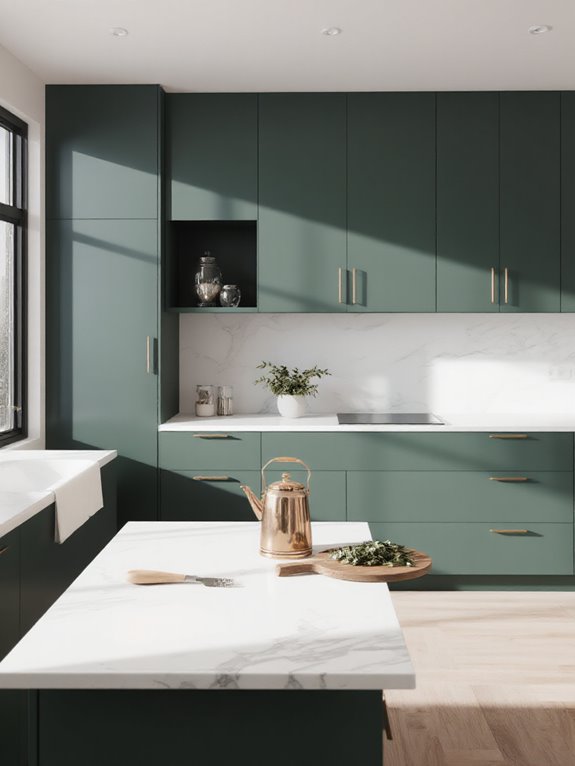
Though often overlooked, forest green kitchen cabinets can transform a space into a serene yet striking environment that feels both rejuvenating and grounded. I’ve found this deep, earthy tone brings a sense of nature indoors, creating a calming atmosphere that’s perfect for cooking and gathering.
Pair it with natural materials like wood or stone for a cohesive look, or add brass hardware for a touch of elegance. Forest green also works well in both modern and traditional designs, offering versatility.
It’s a bold choice, but when balanced with neutral tones, it becomes timeless rather than overwhelming.**
Warm Beige
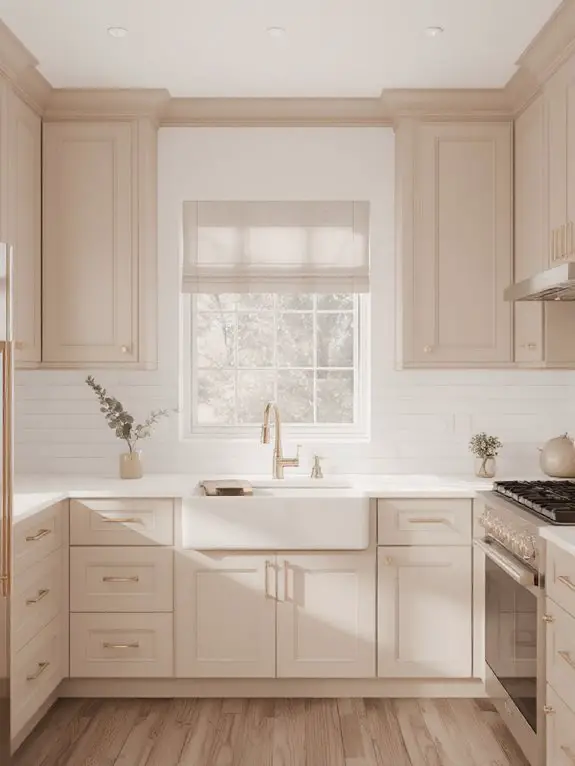
Warm beige kitchen cabinets offer a timeless and versatile foundation that can adapt to a range of design styles while creating a welcoming atmosphere. I love how they bring a sense of calm and balance to the space, making it feel both cozy and elegant.
Pairing them with neutral tones like cream or soft gray enhances their warmth, while adding pops of metallics or natural wood accents keeps the look fresh. I’ve found they’re perfect for blending traditional and modern elements, allowing you to personalize your kitchen without overwhelming the space.
Warm beige truly makes any kitchen feel like a comforting retreat.
Bold Red
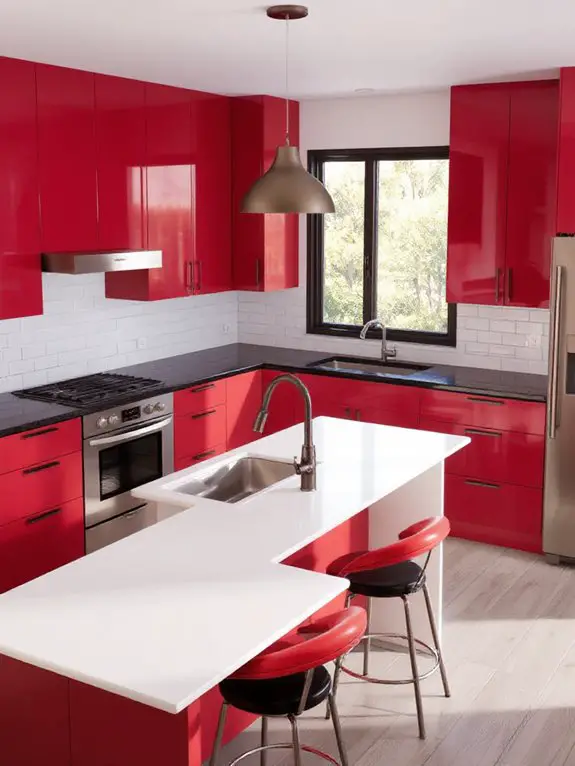
When incorporating bold red into kitchen cabinets, it’s essential to approach the color with intention, as it can transform the space into a vibrant focal point. I recommend balancing it with neutral countertops or backsplashes to prevent overwhelming the room.
Matte finishes soften the intensity, while high-gloss amplifies its drama. Pairing red with natural wood tones adds warmth, and stainless steel appliances lend a modern edge.
Consider lighting—red can appear darker in low light, so guarantee adequate illumination. Test swatches in your space before committing, as undertones vary. Used strategically, bold red creates a kitchen that’s energetic yet refined.
Pale Pink
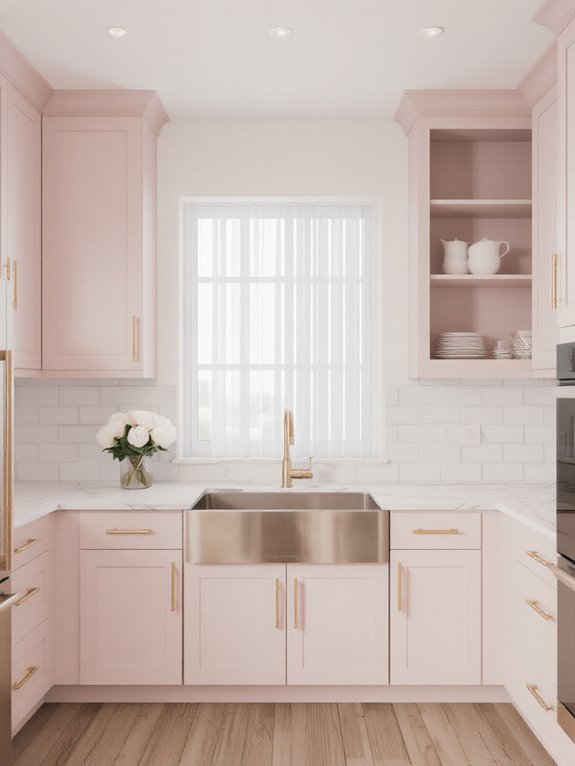
If you’re considering pale pink for your kitchen cabinets, it’s a versatile choice that can create a soft, inviting atmosphere without sacrificing sophistication. I’d pair it with matte gold or brass hardware for a touch of elegance, or opt for white or gray countertops to balance its warmth.
Pale pink works beautifully in both modern and traditional kitchens, especially when complemented with natural wood accents or marble backsplashes. Keep lighting in mind—soft, warm bulbs enhance its cozy vibe, while natural light keeps it fresh.
It’s a subtle yet impactful way to add personality without overwhelming the space.
Rich Charcoal
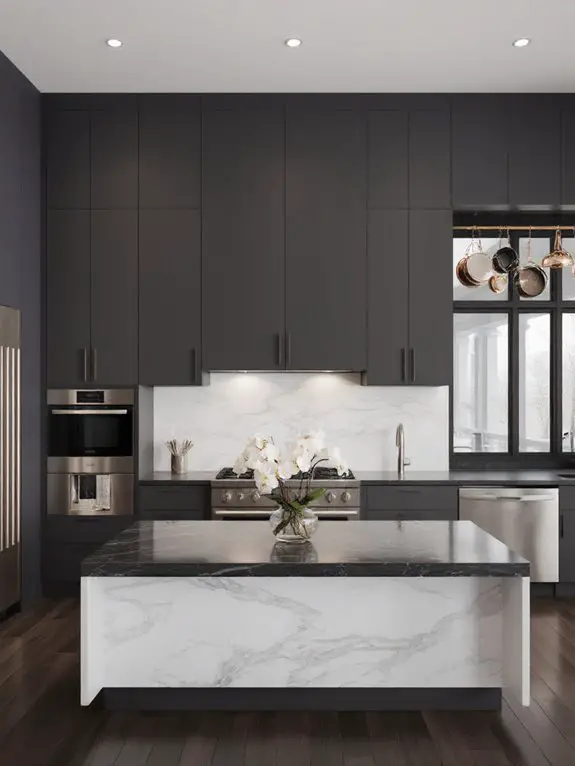
Rich charcoal kitchen cabinets bring a bold, modern edge to any space while maintaining a timeless appeal. I love how they instantly elevate the room’s sophistication, pairing beautifully with stainless steel appliances or brushed gold hardware. They’re also surprisingly versatile—works flawlessly in minimalist designs or when mixed with warm wood tones for contrast.
One tip I’d suggest is balancing the depth of charcoal with lighter countertops or backsplashes to prevent the space from feeling too heavy. It’s a durable choice too, hiding smudges and wear gracefully.
If you’re craving drama without overwhelming your kitchen, rich charcoal is a striking and practical option.
Sunny Yellow
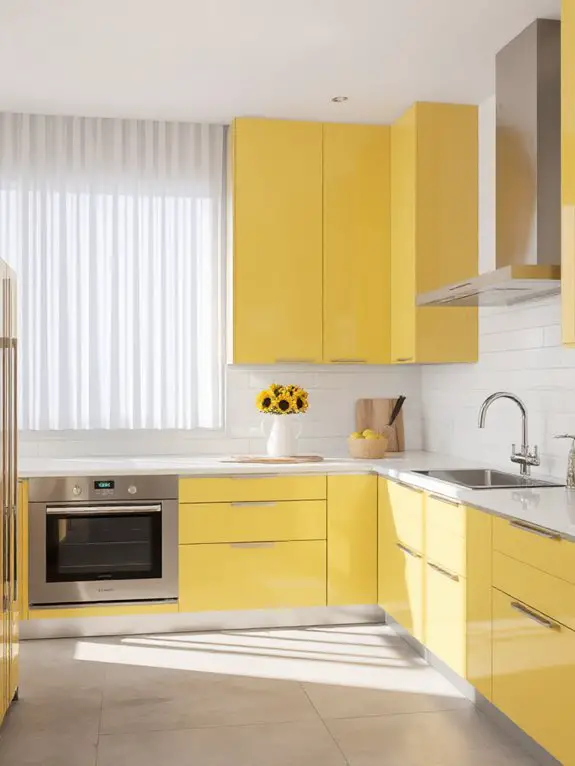
Sunny yellow kitchen cabinets inject a vibrant, uplifting energy into any space, making it feel brighter and more inviting. I love how this shade instantly lifts the mood, especially in kitchens with limited natural light.
Pair it with crisp white countertops or stainless steel appliances for a modern contrast, or soften the look with warm wood accents.
Keep in mind that bold yellows work best in moderation—consider using them for lower cabinets or an island to balance the intensity.
For a subtler approach, opt for muted or pastel yellows. Either way, this hue brings a cheerful, sunlit vibe to your cooking space.
Earthy Brown
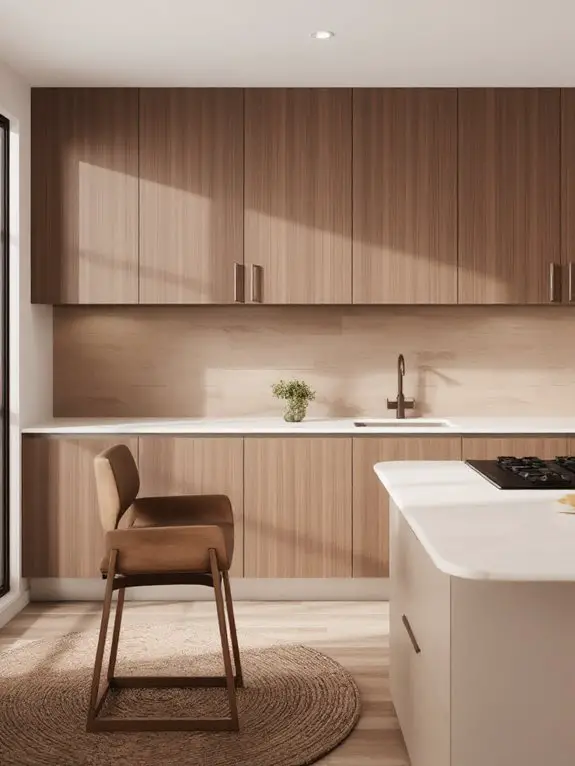
Earthy brown kitchen cabinets bring a grounded, natural warmth to any kitchen, creating a cozy and timeless atmosphere. I love how this color evokes the feeling of wood and soil, making the space feel inviting and connected to nature.
It’s versatile, pairing well with neutral tones like beige or cream, and adds depth when contrasted with crisp white accents. For a modern twist, I recommend matte finishes, while glossy options lend a sleek polish.
Earthy brown cabinets age gracefully, never feeling outdated, and they’re perfect for those who want a kitchen that feels both refined and effortlessly warm.
Cool Mint
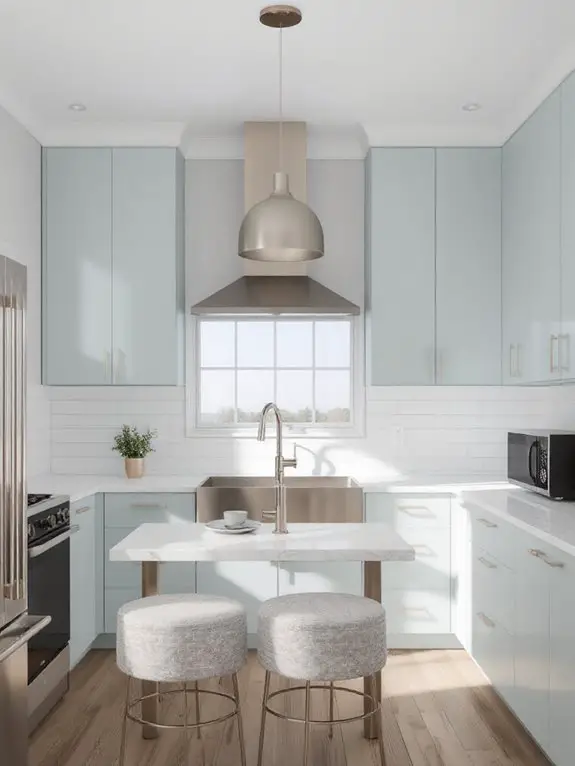
When selecting a color like cool mint for kitchen cabinets, I find it’s essential to assess its invigorating and calming properties, which can transform the space into a tranquil haven. This gentle, subdued green-blue shade brings a revitalizing energy, ideal for fostering a relaxed and welcoming environment.
I suggest pairing it with bright white countertops or warm wood accents to counteract its chill. It fits seamlessly in both contemporary and classic kitchens, particularly in areas with abundant natural light.
Keep hardware understated—brushed nickel or chrome enhances its crispness. Cool mint’s adaptability makes it an enduring option for a peaceful culinary oasis.
Deep Purple
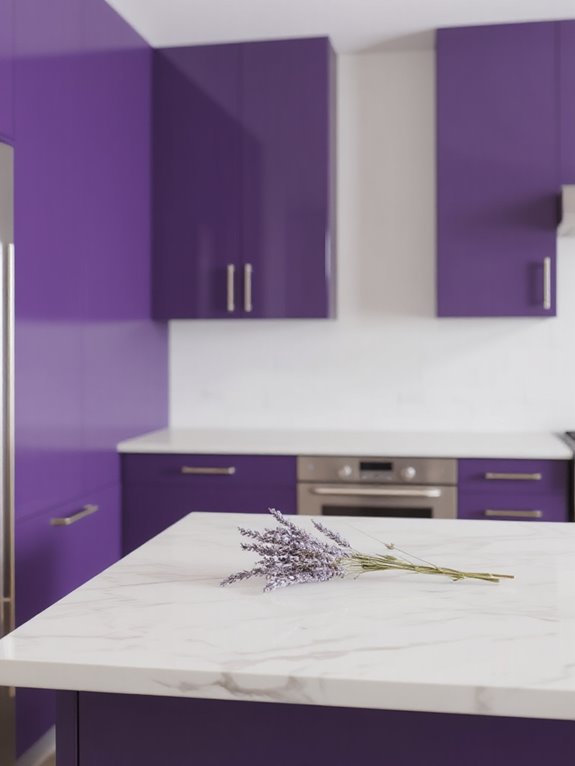
Though it’s a bold choice, deep purple can bring a sense of luxury and sophistication to kitchen cabinets, creating a space that feels rich and moody.
I’d recommend pairing it with matte black hardware or brushed gold accents to elevate the drama while maintaining balance. Deep purple works beautifully in kitchens with natural light, as it prevents the space from feeling too dark.
If you’re hesitant, consider using it on lower cabinets or an island while keeping upper cabinets neutral. This shade pairs well with white countertops or marble surfaces to keep the look refined and cohesive.
Creamy Ivory
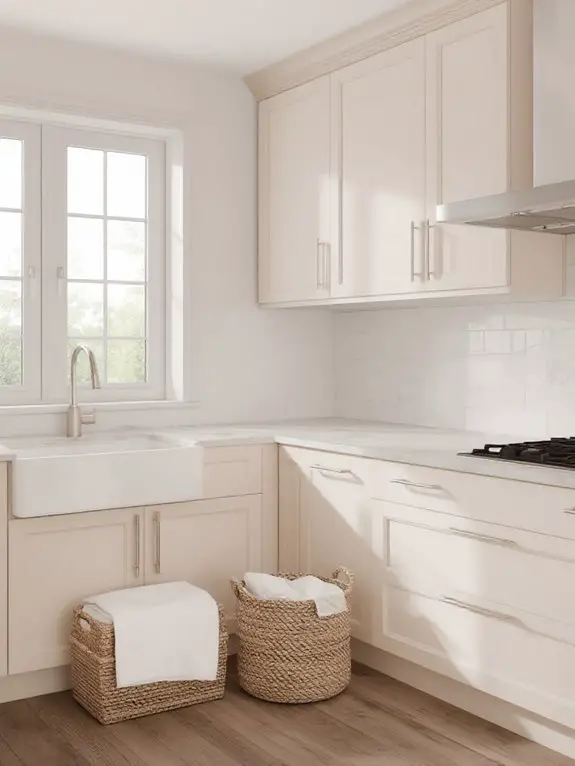
Creamy ivory offers a timeless and versatile palette for kitchen cabinets, blending warmth with a clean, elegant aesthetic. I love how it complements both traditional and modern designs, making it a go-to choice for any kitchen style. It’s soft enough to brighten a space without feeling stark, yet rich enough to add depth and sophistication.
Pair it with natural wood accents for a cozy vibe or sleek metallic hardware for a contemporary edge. I’ve found it’s forgiving with fingerprints and smudges, which is a bonus in high-traffic kitchens.
This neutral hue creates a serene backdrop, allowing other design elements to shine.
Vibrant Orange

If you’re looking to inject energy and boldness into your kitchen, vibrant orange cabinets can make a striking statement. I’d recommend pairing them with neutral tones like white or gray to balance the intensity and prevent the space from feeling overwhelming.
Matte finishes work well to soften the look, while glossy surfaces amplify the color’s vibrancy. Consider incorporating natural materials like wood or stone for texture and warmth.
Lighting is key—opt for warm, soft bulbs to enhance the cozy feel. Vibrant orange works best in modern or eclectic kitchens, where it can serve as a bold focal point without clashing.
Dusty Rose
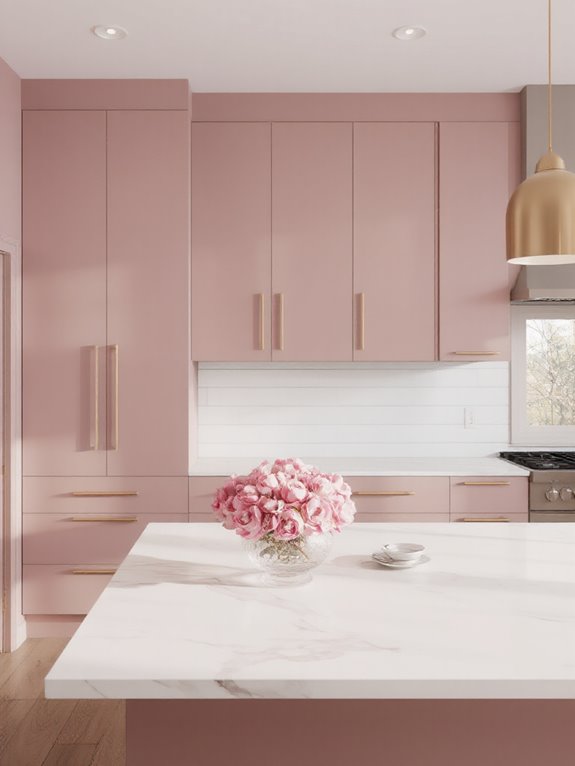
Dusty rose offers a softer, more refined alternative to bolder cabinet colors like vibrant orange. I find it brings a warm, elegant touch to kitchens without overwhelming the space.
Its muted tone pairs beautifully with natural materials like light wood or marble countertops, creating a timeless look.
I recommend using it in well-lit areas to enhance its warmth and prevent it from feeling too heavy. Pairing it with brass or gold hardware adds a luxurious contrast, while white or cream walls keep the space feeling fresh.
It’s ideal for those seeking a sophisticated yet inviting kitchen aesthetic.
Slate Blue
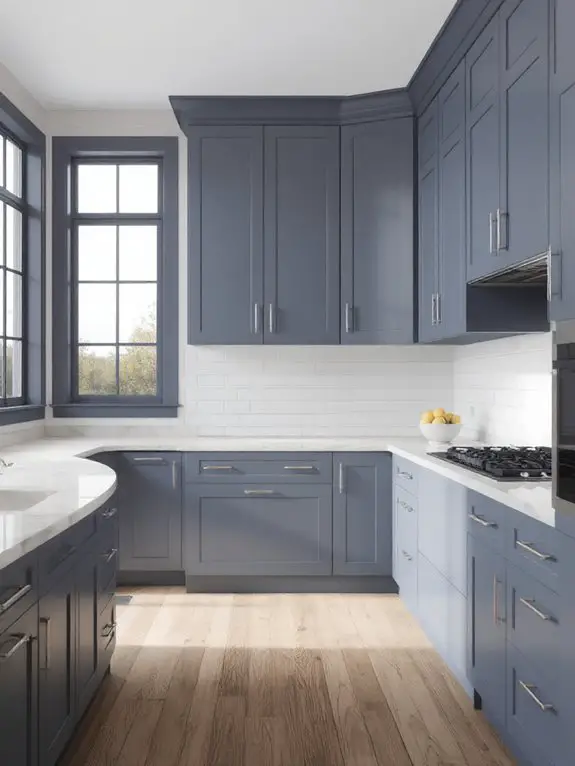
While slate blue may seem like a cool, modern choice for kitchen cabinets, it’s surprisingly versatile, working well in both traditional and contemporary spaces. I love how it pairs with warm wood tones or crisp white countertops, creating a balanced look.
For a cohesive feel, consider brushed brass or matte black hardware—both complement slate blue beautifully. If you’re worried about the color feeling too dark, opt for upper cabinets in white or cream to keep the space airy.
This shade also hides smudges better than lighter hues, making it practical for busy kitchens. It’s a timeless choice that adds depth without overwhelming.
Golden Tan
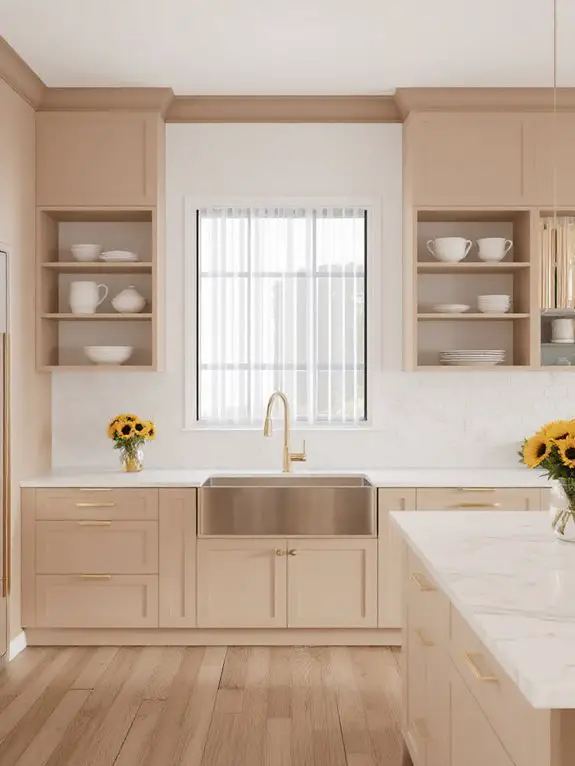
Though golden tan might evoke thoughts of neutral palettes, it’s a surprisingly dynamic color for kitchen cabinets that can infuse warmth and sophistication into any space. I’ve found it pairs beautifully with natural materials like wood or stone, creating a cohesive, earthy vibe.
It’s versatile too—pair it with crisp whites for a clean look or deeper browns for a richer feel. I love how it reflects light, making smaller kitchens feel more open.
Golden tan also hides minor scuffs and fingerprints better than lighter shades, which is a bonus for busy households. It’s timeless, yet fresh—a perfect balance.
Teal
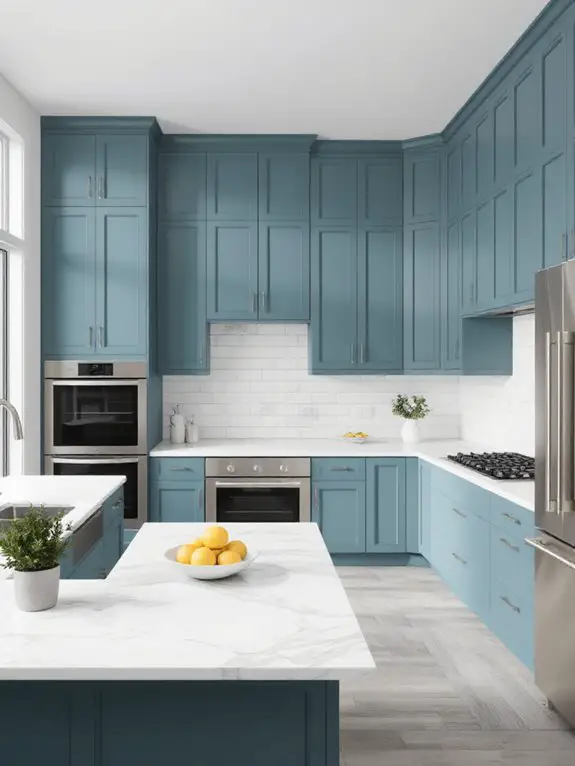
Teal brings a bold yet balanced energy to kitchen cabinets, offering a vibrant alternative to traditional neutrals without overwhelming the space. I love how it combines the calming qualities of blue with the invigorating freshness of green, creating a versatile hue that works in both modern and traditional kitchens.
Pair it with warm brass or gold hardware for a luxe feel, or keep it sleek with matte black accents. Teal also pairs beautifully with natural wood tones or crisp white countertops, making it adaptable to various design styles.
It’s a statement color that feels sophisticated, not overwhelming, when used thoughtfully.
Light Blue
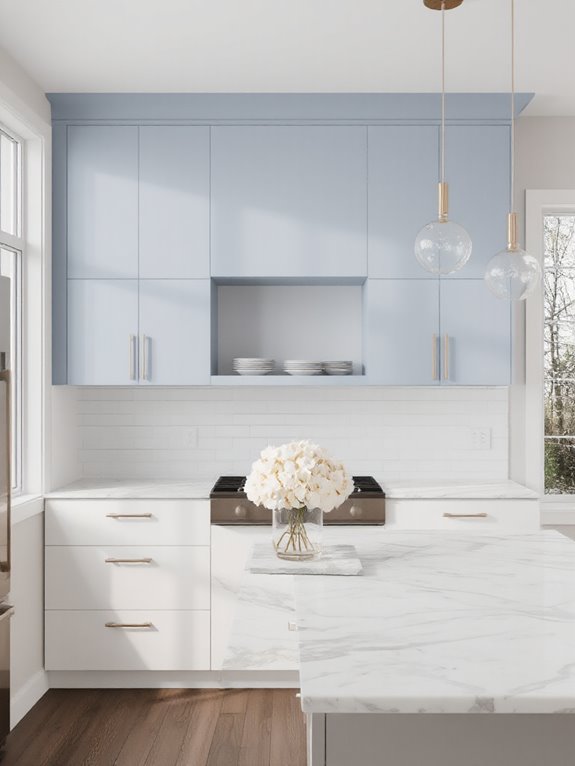
Light blue offers a serene and airy aesthetic for kitchen cabinets, making it an excellent choice for creating a calming and inviting space. I’ve found it pairs beautifully with white countertops or stainless steel appliances for a clean, modern look.
It’s versatile too—lighter shades feel fresh and beachy, while deeper tones add subtle sophistication. I’d recommend using matte or satin finishes to maintain its soft, elegant vibe.
If you’re worried about it feeling too cold, add warmth with natural wood accents or brass hardware. Light blue is timeless, so it’s a color you won’t tire of quickly.
Sage Green
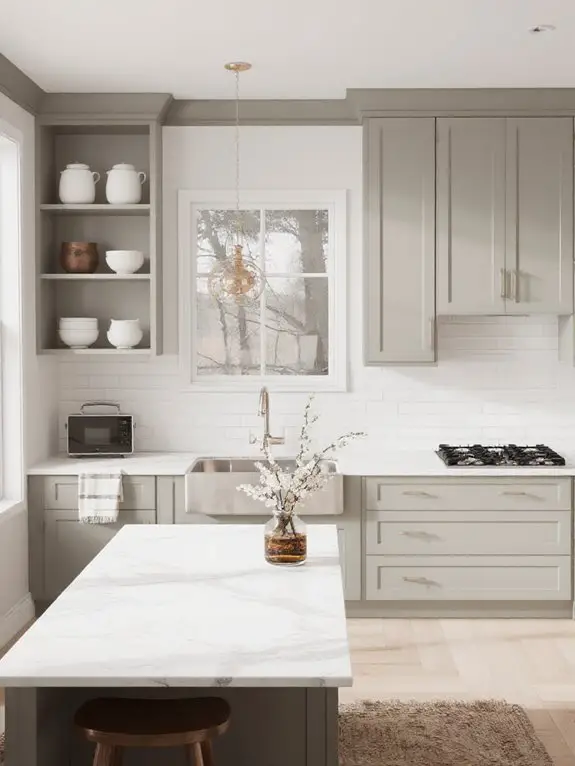
When considering kitchen cabinet colors, sage green stands out as a timeless and versatile choice that effortlessly blends warmth and tranquility. I love how it brings a calming, natural feel to the kitchen, making the space feel both inviting and revitalizing.
Its muted tone pairs beautifully with a variety of materials, like wood, brass, or marble, allowing for endless design possibilities. I often recommend pairing it with white countertops or soft gray walls for a balanced, sophisticated look.
Sage green also hides smudges and fingerprints well, making it practical for everyday use. It’s a color that feels modern yet classic, ensuring your kitchen stays stylish for years.
Taupe
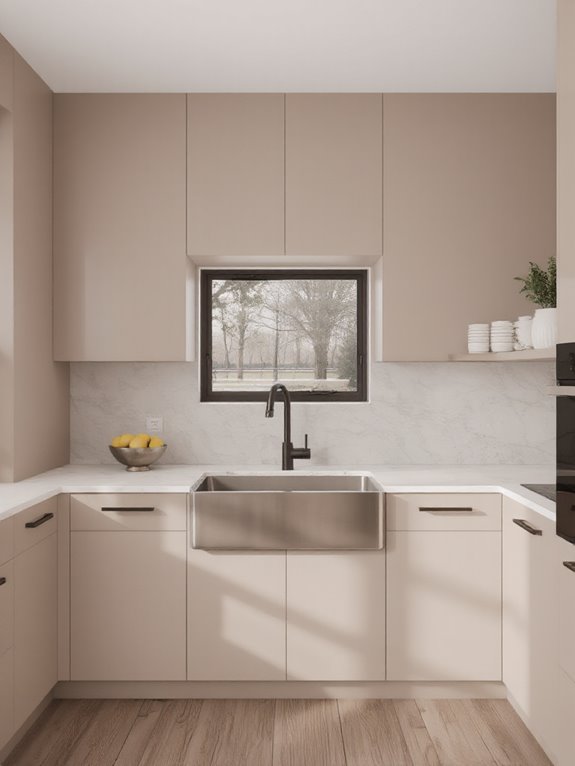
Because of its understated elegance and adaptability, taupe has become a go-to choice for kitchen cabinets, offering a neutral yet sophisticated foundation for any design. I love how it balances warm and cool undertones, making it versatile for pairing with various finishes and textures.
Pair it with brushed nickel hardware for a modern look or antique brass for a vintage vibe. Taupe also complements a wide range of countertop materials, from marble to butcher block.
Its timeless appeal guarantees your kitchen won’t feel dated, and it works beautifully in both contemporary and traditional spaces. It’s a practical yet stylish choice.
Burgundy
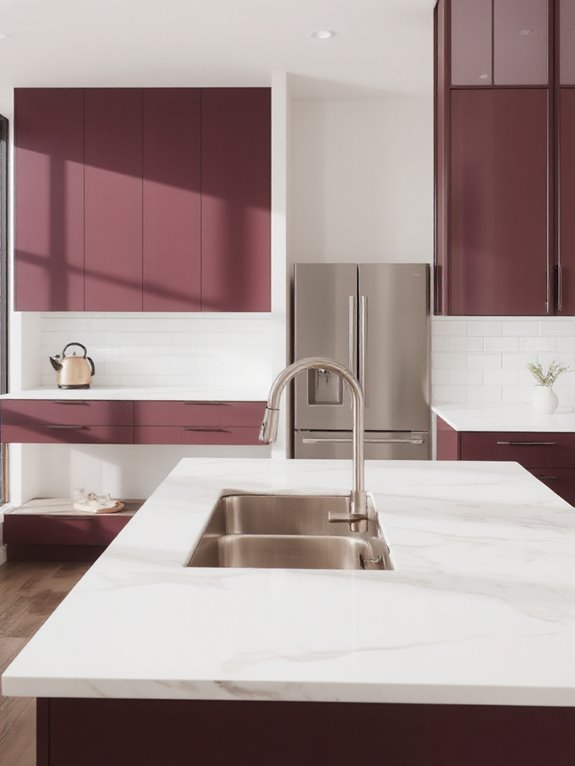
Though bold and dramatic, burgundy brings a rich, luxurious depth to kitchen cabinets that can elevate the entire space. I’ve found it pairs beautifully with natural wood accents and matte black hardware for a modern yet timeless look.
If you’re worried it might feel too dark, balance it with lighter countertops or backsplashes in cream or white. Burgundy also complements metallic finishes like brass or copper, adding warmth and sophistication.
I’d recommend testing samples in your kitchen’s lighting to confirm the shade works with your space. It’s a statement, but when done right, it creates a stunning, inviting atmosphere.
Pastel Lavender
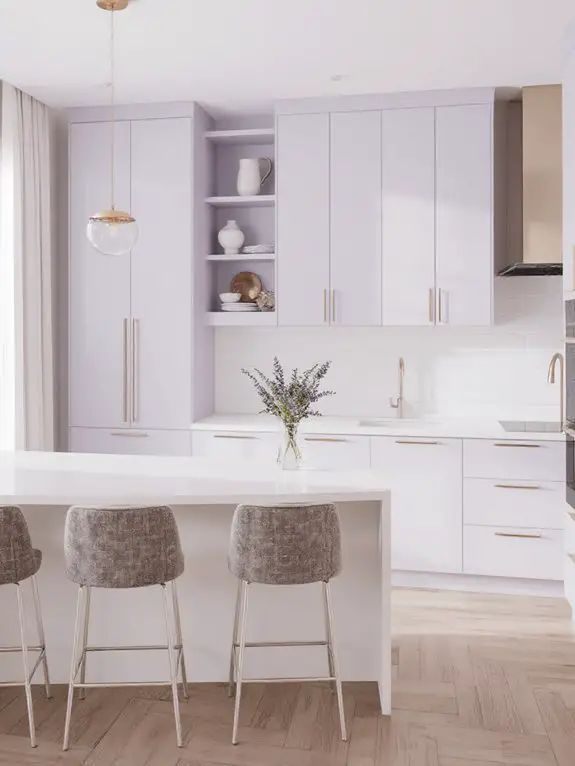
If you’re looking to introduce a soft, calming vibe to your kitchen, pastel lavender is a versatile choice that balances elegance and tranquility. This subtle hue pairs beautifully with white or light gray countertops, creating a serene and airy feel.
I’d recommend using it in smaller kitchens to make the space feel larger, or as an accent for upper cabinets to contrast with neutral lowers. Pair it with brushed nickel or chrome hardware to enhance its modern appeal.
Pastel lavender also complements natural wood tones, adding warmth without overwhelming the space. For a cohesive look, tie it into your backsplash or decor accents.
Espresso
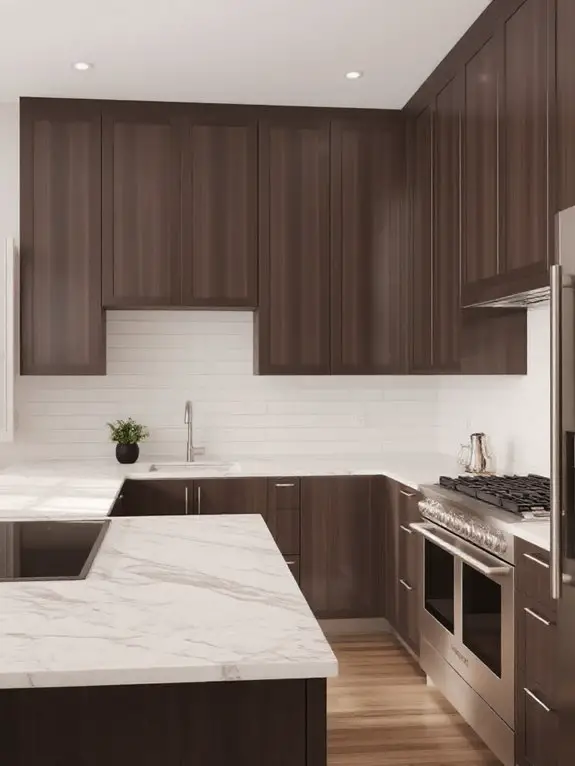
Espresso is a rich, deep brown shade that brings sophistication and warmth to any kitchen. I love how it pairs effortlessly with stainless steel appliances or brushed gold hardware for a modern yet timeless look.
It’s versatile enough to work in both traditional and contemporary spaces, especially when balanced with light countertops or backsplashes. The dark tone hides smudges well, making it practical for busy households.
Just be mindful of lighting—espresso can feel heavy in smaller kitchens, so I recommend ample natural or artificial light to keep the space inviting. It’s a bold choice that elevates the room without overwhelming it.
Frequently Asked Questions
How Do I Choose the Right Finish for My Cabinets?
I’d consider durability, maintenance, and style when choosing a cabinet finish. I’ll think about how often I use my kitchen and if I want a glossy, matte, or textured look that complements my space.
What’S the Best Way to Clean Painted Cabinets?
I’ve found that gentle cleaning works best for painted cabinets. I use a soft cloth and mild soap mixed with water to avoid damaging the finish. I avoid harsh chemicals and always dry them immediately to prevent streaks.
Can I Mix Cabinet Colors in One Kitchen?
Can I mix cabinet colors in one kitchen? You bet, just like I’d mix a groovy vinyl collection. I’d choose shades that complement each other—maybe darker lowers and lighter uppers—to create balance and keep it from looking like a madhouse.
How Long Does Cabinet Paint Typically Last?
I’ve found cabinet paint typically lasts 5-10 years if properly prepped and applied. Daily wear and tear, like cleaning or moisture, can affect its lifespan, but high-quality paint and a good finish make all the difference.
Are There Eco-Friendly Cabinet Paint Options?
Did you know 90% of eco-friendly paints are water-based? I’m always looking for sustainable choices, so I’d recommend low-VOC or zero-VOC paints. They’re better for the environment and my health, plus they still give cabinets a flawless finish.

